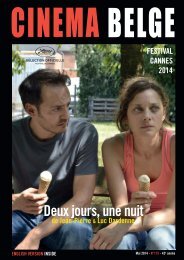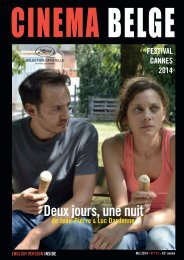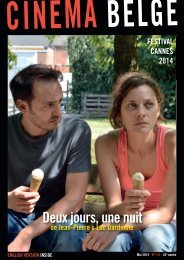CINEMA
Create successful ePaper yourself
Turn your PDF publications into a flip-book with our unique Google optimized e-Paper software.
Since it was created 13 years ago, Wallimage has<br />
consistently demonstrated over the years its<br />
ability to adapt to the needs of the sector and<br />
to anticipate changes in production in terms of both<br />
funding and habitual practices and formats. “Wallimage’s<br />
‘traditional’ funding lines are now up to<br />
speed,” explains its director Philippe Reynaert.<br />
“Moreover, as they are economically neutral for the<br />
Region (given that the amount spent in Wallonia is<br />
on average three times higher than the amount invested<br />
by the fund, resulting in tax revenues equivalent<br />
to the investment – ed.), we can feel confident<br />
about their sustainability. However, that doesn’t<br />
mean we can rest on our laurels! The production environment<br />
is changing rapidly and the spread of<br />
digital technology is having an impact on traditional<br />
funding models.”<br />
With an annual budget of<br />
€5 million, the economic<br />
fund in support of<br />
Flemish film production is clearly<br />
ambitious. “It was launched in 2012.<br />
Since then we have received and<br />
analysed 56 film projects, of which<br />
we have selected 40. Our maximum<br />
investment is €400,000,” says Jan<br />
Roekens, who has been head of<br />
Screen Flanders at the Flemish Audiovisual<br />
Fund (VAF) since January.<br />
Screen Flanders’ budget in fact derives<br />
from the agency Enterprise<br />
Flanders. The viewpoint is thus definitely<br />
economic. “We act as coproducers,<br />
with the potential to receive<br />
revenue in the right circumstances.”<br />
In order to access this fund, you<br />
must meet three conditions: you<br />
must be a Belgian producer, you<br />
must already have secured at least<br />
50% of your funding, and you must<br />
plan to spend at least €250,000 in<br />
the Flemish Region.<br />
The fund’s objective is to encourage<br />
Update<br />
Wallimage<br />
Perpetuate and explore!<br />
Paradoxically, this changing context seems to be<br />
boosting the Walloon fund’s dynamism. For the last<br />
three years, Wallimage has implemented its Crossmedia<br />
funding line through the Creative Wallonia<br />
programme. “All the studies show that the future of<br />
the audiovisual sector lies in media convergence.<br />
This funding line is a little like our R&D department,<br />
and it has enabled us to encounter other Walloon<br />
creative companies active in fields other than<br />
purely audiovisual activity.”<br />
Another challenge is Brussels! The Brussels economic<br />
fund, Bruxellimage, was set up there five<br />
years ago in collaboration with the sole Belgian<br />
economic fund that existed at that time, namely<br />
Wallimage. With the arrival of Screen Flanders, relations<br />
between the three Regions will need to be<br />
redefined. Nevertheless, links between the two Regions<br />
are strong: Wallimage and Bruxellimage have<br />
together opened a new line of support for television<br />
series to the tune of one million euros, attracting<br />
series such as Métal Hurlant in Marcinelle<br />
or Which is Witch in Liège. If the next four RTBF<br />
series (under development) incur expenses in Wallonia,<br />
this line should also contribute to their production.<br />
Finally, starting this year the two Regions are investing<br />
in the organisation of a genre film market:<br />
Frontières. This originates from Montreal, but a<br />
combined version has just been organised in the<br />
European capital. “Belgian independent films are<br />
already well recognised abroad. It is essential to encourage<br />
other types of cinema...” . ■ V.B.<br />
Screen Flanders<br />
Launch and attract!<br />
Jan Roekens, Head of Screen Flanders at the VAF<br />
Philippe Reynaert<br />
Director of Wallimage<br />
the structuring of the Flemish industry.<br />
“In this context, we also encourage<br />
the participation of mainly<br />
foreign films. We want to attract<br />
them here.” This is where the complementarity<br />
with the VAF makes a<br />
difference, as the VAF provides a cultural<br />
viewpoint, whereas Screen<br />
Flanders’ outlook is more economic.<br />
“When we work with both funding<br />
bodies on a film, we ensure that<br />
there is no overlap between the two<br />
in terms of spending. Costs covered<br />
by the one are not covered by the<br />
other.”<br />
Another not insignificant factor is<br />
the desire to invest in Flemish expertise.<br />
“We prefer to spend on a<br />
film that employs a Flemish head<br />
cameraman or a Flemish actor, rather<br />
than just Flemish extras,” continues<br />
Jan Roekens. “It is these talented<br />
and/or experienced men and women<br />
who are the backbone of the cinema,<br />
so it is vital for us to encourage the<br />
use of their services.” .■ V.B.<br />
Belgian Cinema III May 2014





